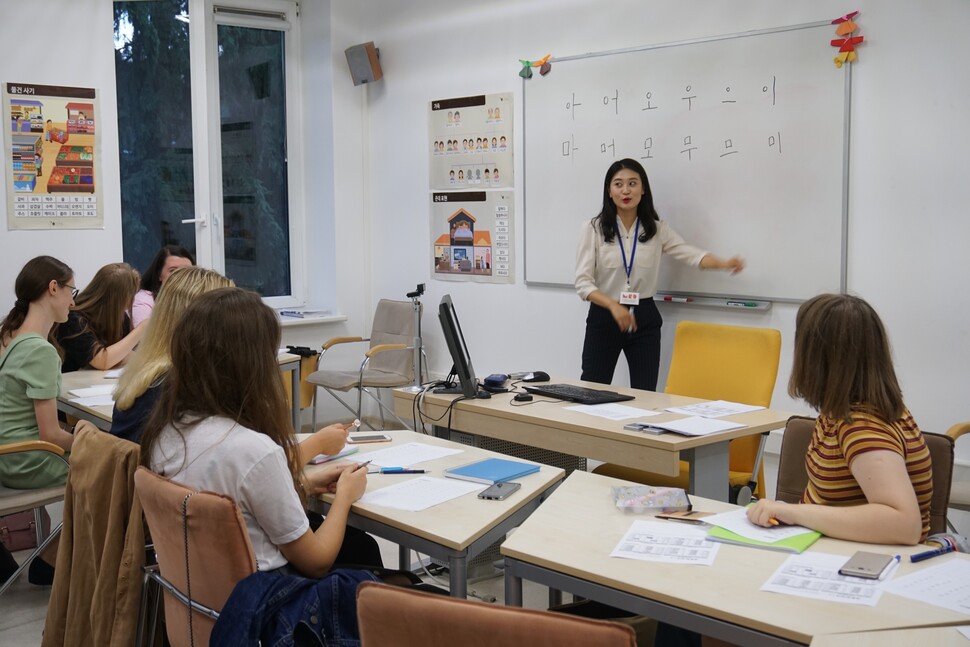[Oct] Korean language learning expands globally thanks to Hallyu
Date Oct 21, 2022
 Hangeul was invented in 1443 and promulgated in 1446 by King Sejong the Great during the Joseon Dynasty. (Courtesy of gettyimagesbank )
Hangeul was invented in 1443 and promulgated in 1446 by King Sejong the Great during the Joseon Dynasty. (Courtesy of gettyimagesbank )
Korea is one of the few countries in the world that has its own phonetic alphabet. Called Hangeul, the Korean script is even more unique as it is the only alphabet whose time and means of creation as well as the name of its creator are all well documented.
Hangeul was created in 1443 and promulgated in 1446 by King Sejong the Great of the Joseon Dynasty (1392-1910). Before it existed, Koreans had to write down their words and thoughts through Chinese characters. Ordinary people often lacked the time and resources needed to learn to read and write, and even when the proper characters were learned, they often failed to accurately replicate the sound and meaning of Korean words. Thus, Sejong himself personally oversaw the creation of Hunminjeongeum, an alphabet whose name said it all: Correct Sounds for the Instruction of the People.
Modern Hangeul has slimmed Hunminjeongeum’s original 17 consonants and 11 vowels down to 14 consonants and 10 vowels, but their shapes have stayed largely unchanged. The consonants were made by a scientific approach rooted in linguistic concepts. They are representations of the location of the tongue, lips, teeth and throat when the respective sounds are made. For example, giyeok (ㄱ) shows the root of the tongue arched up to block the throat, like the tongue must be to make the sounds that the speakers of many languages replicate with the Roman letters “g” and “k.” Hangeul is also one of the easiest alphabets to learn; nearly anyone can memorize its letters and corresponding sounds within a few hours.
A phonogram, Hangeul can be used to accurately transcribe nearly every sound from any language. The few exceptions are those that do not exist in Korean like “f” or “ɚ” (the vowel found at the end of “dollar” or “butter.” But around the world, people are discovering that Hangeul fits their tongues perfectly and are taking advantage of its ease. Some members of the Cia Cia, a tribe on a remote Indonesian island, began transcribing their spoken language with Hangeul in 2009. Since then, several indigenous communities in Thailand, Nepal and Bolivia have adopted Hangeul to record their spoken languages in written form.
Koreans are so proud of their alphabet and its accomplishments that they have even designated a national holiday for it. Hangeul Day is officially October 9, and if that happens to fall on a weekend, as in this year, most workers are still given the following Monday off to celebrate.
The excellence of Hangeul is recognized not only by Koreans: UNESCO registered the Hunminjeongeum Manuscript, which explains the origins of Hangeul, as a Memory of the World in 1989.
 Students learn Hangeul, the Korean alphabet, at King Sejong Institute Vilnius, the educational institution of the Korean language and culture at Mykolas Romeris University, Lithuania. (Courtesy of King Sejong Institute Foundation)
Students learn Hangeul, the Korean alphabet, at King Sejong Institute Vilnius, the educational institution of the Korean language and culture at Mykolas Romeris University, Lithuania. (Courtesy of King Sejong Institute Foundation)
In recent years, a growing number of people around the world have become interested in learning Hangeul and the Korean language, largely due to the growing influence of Hallyu or the Korean wave, evident by K-pop, K-films and K-dramas sweeping the world. To meet that demand and promote Korean culture, the government has been supporting relevant classes around the world.
The King Sejong Institute, a government-run Korean language school, is a prime example. There were 13 of the institutes in three countries when the King Sejong Institute Foundation was established in 2007, but as of June 2022, there were 244 institutes in 84 countries. Seven have opened this year alone, one each in Bangladesh, Saudi Arabia, Kuwait, South Africa, Tunisia, Luxembourg and Finland, and the government aims to raise the total number to 270 by the end of this year.
King Sejong Institute enrollment has grown from 740 in 2007 to over 80,000 students now, and the cumulative number of students enrolled from 2007 through 2021 stands at 584,174. More information about the King Sejong Institute can be found at www.ksif.or.kr.
Besides the King Sejong Institute, the number of universities that offer Korean studies or language courses has been steadily growing as well. In 1991, there were only 151 universities in 32 countries where students could take courses related to Korea, according to the Korea Foundation. But by 2022, the number had spiked to 1,408 – a near 10-fold increase.
Also, a growing number of secondary schools around the world offer Korean language courses. Eighteen countries, including the United States, Japan and France, now have Korean as an option for second-language electives in their public education curricula. Presently, students can study Korean at around 1,800 schools in 43 countries.
**If you have any questions about this article, feel free to contact us at kocis@korea.kr.**

The Ministry of Culture, Sports and Tourism's "Korea Here & Now" work can be used under the condition of "Public Nuri Type 1 (Source Indication)."




